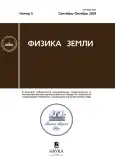A Spherical Block Model of Lithosphere Dynamics and Seismicity: Current State and Development Prospects
- Authors: Rozenberg V.L.1,2
-
Affiliations:
- Krasovskii Institute of Mathematics and Mechanics, Ural Branch, Russian Academy of Sciences
- Ural Federal University
- Issue: No 5 (2024)
- Pages: 173-182
- Section: Articles
- URL: https://journals.eco-vector.com/0002-3337/article/view/658160
- DOI: https://doi.org/10.31857/S0002333724050128
- EDN: https://elibrary.ru/EJMFFI
- ID: 658160
Cite item
Abstract
A description of the evolution of a spherical block model of the dynamics and seismicity of the lithosphere is given. The main focus is on the current version and the introduction of a constructive automatic calibration (parameter selection) procedure to obtain the best approximation of key properties of regional and/or global seismicity. The paper presents some results of computational experiments.
Full Text
About the authors
V. L. Rozenberg
Krasovskii Institute of Mathematics and Mechanics, Ural Branch, Russian Academy of Sciences; Ural Federal University
Author for correspondence.
Email: rozen@imm.uran.ru
Russian Federation, Yekaterinburg, 620990; Yekaterinburg, 620075
References
- Аки К., Ричардс П. Количественная сейсмология: теория и методы. Т. 1, 2. М.: Мир. 1983. 720 с.
- Мельникова Л.А., Розенберг В.Л. Сферическая блоковая модель динамики и сейсмичности литосферы: различные модификации и вычислительные эксперименты. Екатеринбург: Труды ИММ УрО РАН. 2007. T. 13. № 3. C. 95–120.
- Мельникова Л.А., Розенберг В.Л. Стохастическая модификация сферической блоковой модели динамики и сейсмичности литосферы // Вычислительные методы и программирование. 2015. T. 16. C. 112–122.
- Мельникова Л.А., Розенберг В.Л., Соболев П.О., Соловьев А.А. Численное моделирование динамики системы тектонических плит: сферическая модификация блоковой модели // Вычислительная сейсмология. 2000. Вып. 31. С. 138–153.
- Розенберг В.Л. Сферическая блоковая модель динамики и сейсмичности литосферы: современное состояние и перспективы развития. Материалы докладов III Всероссийской научной конференции с международным участием “Современные методы оценки сейсмической опасности и прогноза землетрясений”, 25–26 октября 2023 г., Москва, Россия. C. 224–228.
- Соловьев А.А., Горшков А.И. Моделирование динамики блоковой структуры и сейсмичности Кавказа // Физика Земли. 2017. № 3. С. 1–11. doi: 10.7868/S0002333717030127
- Соловьев А.А., Горшков А.И. Моделирование сейсмичности региона Алтай-Саяны-Прибайкалье // Докл. РАН. Науки о Земле. 2021. T. 501. № 2. С. 204–209. doi: 10.31857/S2686739721120136
- Digas B., Melnikova L., .Rozenberg V. Application of parallel technologies to modeling lithosphere dynamics and seismicity / Wyrzykowski R. et al. (eds.): PPAM 2009, Part II. Lecture Notes in Computer Science (LNCS). 2010. V. 6068. P. 340–349.
- Gabrielov A.M., Newman W.I. Seismicity modeling and earthquake prediction: a review. Geophysical Monograph 83. IUGG, Washington. 1994. V. 18. P. 7–13.
- Global Hypocenters Data Base, NEIC/USGS, Denver, CO. URL: http://earthquake.usgs.gov/regional/neic/
- Gripp A.E., Gordon R.G. Young tracks of hotspots and current plate velocities // Geophysical Journal International. 2002. V. 150. P. 321–361. doi: 10.1046/j.1365-246x.2002.01627.x
- Ismail-Zadeh A.T., Le Mouel J.-L., Soloviev A.A., Tapponnier P., Vorobieva I.A. Numerical modeling of crustal block-and-fault dynamics, earthquakes and slip rates in the Tibet-Himalayan region // Earth and Planetary Science Letters. 2007. V. 258. P. 465–485.
- Ismail-Zadeh A.T., Soloviev A.A. Numerical modelling of lithospheric block-and-fault dynamics: what did we learn about large earthquake occurrences and their frequency? // Surveys in Geophysics. 2022. V. 43. P. 503–528. doi: 10.1007/s10712-021-09686-w
- Ismail-Zadeh A., Soloviev A., Sokolov V., Vorobieva I., Muller B., Schilling F. Quantitative modeling of the lithosphere dynamics, earthquakes and seismic hazard // Tectonophysics. 2018. V. 746. P. 624–647. doi: 10.1016/j.tecto.2017.04.007
- Keilis-Borok V.I., Soloviev A.A. (Eds.) Nonlinear dynamics of the lithosphere and earthquake prediction. – Berlin: Springer. 2003. – 337 P. doi: 10.1007/978-3-662-05298
- Melnikova L., Mikhailov I., Rozenberg V.Simulation of global seismicity: new computing experiments with the use of scientific visualization software / Sokolinsky L., Zymbler M. (eds.). Parallel Computational Technologies. PCT 2017. Communications in Computer and Information Science (CCIS). 2017. V. 753. P. 215–232. doi: 10.1007/978-3-319-67035-5-16
- Oksendal B. Stochastic differential equations: an introduction with application. New York: Springer. 2003. 360 p. doi: 10.1007/978-3-662-03620-4
- Panza G.F., Soloviev A.A., Vorobieva I.A. Numerical modeling of block-structure dynamics: application to the Vrancea region // Pure and Applied Geophysics. 1997. V. 149. P. 313–336.
- Peresan A., Vorobieva I.A., Soloviev A.A., Panza G.F. Simulation of seismicity in the block-structure model of Italy and its surroundings // Pure and Applied Geophysics. 2007. V. 164. P. 2193–2234. doi: 10.1007/s00024-007-0273-9
- Rozenberg V. Block model of lithosphere dynamics: new calibration method and numerical experiments / Sokolinsky L., Zymbler M. (eds.). Parallel Computational Technologies. PCT 2020.Communications in Computer and Information Science (CCIS). 2020. V. 1263. P. 181–197. DOI: 0.1007/978-3-030-55326-5-13
- Rozenberg V.L., Sobolev P.O., Soloviev A.A., Melnikova L.A. The spherical block model: dynamics of the global system of tectonic plates and seismicity // Pure and Applied Geophysics. 2005. V. 162. P. 145–164. doi: 10.1007/s00024-004-2584-4
- Vorobieva I., Ismail-Zadeh A., Gorshkov A. Nonlinear dynamics of crustal blocks and faults and earthquake occurrences in the Transcaucasian region // Physics of the Earth and Planetary Interiors. 2019. V. 297. doi: 10.1016/j.pepi.2019.106320
- Vorobieva I., Mandal P., Gorshkov A. Block-and-fault dynamics modeling of the Himalayan frontal arc: Implications for seismic cycle, slip deficit, and great earthquakes // Journal of Asian Earth Sciences. 2017. V. 148. P. 131–141. doi: 10.1016/j.jseaes.2017.08.033
- Wells D.L., Coppersmith K.J. New empirical relationships among magnitude, rupture length, rupture width, rupture area, and surface displacement // Bulletin of the Seismological Society of America. 1994. V. 84. № 4. P. 974–1002.
Supplementary files
Supplementary Files
Action
1.
JATS XML
2.
Fig. 1. Recorded seismicity (NEIC, 01.01.1900–12/31/2022 [NEIC...]): the epicenters of strong magnitude earthquakes are shown in circles, the color of which depends on the depth (scale in the lower right corner), the 20 strongest magnitude events in the catalog are marked with asterisks.
Download (1MB)
3.
Fig. 2. Synthetic seismicity (100 units of model time): the epicenters of strong earthquakes with magnitude (see (6)) are shown in circles, the color of which depends on the depth, the 20 strongest magnitude events in the catalog are marked with asterisks.
Download (1MB)









